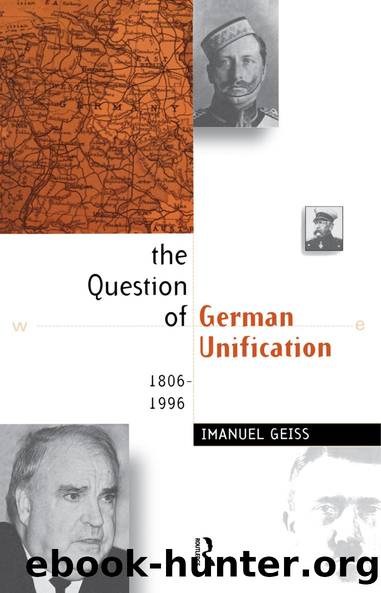The Question of German Unification by Imanuel Geiss

Author:Imanuel Geiss [Geiss, Imanuel]
Language: eng
Format: epub
Tags: History, General
ISBN: 9781136185687
Google: vtJcAgAAQBAJ
Publisher: Routledge
Published: 2013-12-16T03:36:49+00:00
THIRD REICH AND SECOND WORLD WAR, 1933â1945
The external German Question: revision and expansion
The main reason for the victory of National Socialism in the final stages of the kleindeutsch Reich of the Weimar Republic was the Germansâ sense of uncertainty and insecurity regarding their position in Europe and the world. In 1871 the German Question seemed to have been definitively settled, but it had been violently thrown up anew in 1918/19 by the express desire of the German Austrians and the Sudeten Germans in Bohemia and Moravia for Anschluβ with the Reich, and it was now directed at the Germans themselves. What did they want to be in Europe? One nation among others within a system which had hitherto always resisted the hegemony of any single European power? Or was defeat in 1918, at the hands of almost the whole world, merely an incentive to do better next time?
What Hitler and the NSDAP were agitating for, which was borne out by the subsequent course of history up to 1939 and 1945, shows that most Germans preferred the second alternative. The circumstances of Germanyâs geographical position in Europe, the more onerous stipulations of the Treaty of Versailles, the political weakness of her neighbours to the east and the south east â all helped bring about a programme of German revisionism. Hitler merely took over from the Weimar Republic and carried it out, effecting a smooth transition from the limited revisionism of wanting to return to the borders of 1914, to running amok in a Greater German crusade against Europe and the world.
The logic of geography, of the patterns of domestic and foreign policy and of traditional power politics, all combined to produce a sequence of coordinated steps which any bright German schoolchild of the day could reel off: first, political unity and internal consolidation, then external expansion. Hitler achieved internal unity in his centralized, one-party/one-leader state in 1933/34 by a combination of meek compliance and sheer terror, disguised by clever propaganda. At least for members of the German Volk, the bureaucratic state based on the rule of law continued â with limitations â as before, though its source of legitimacy was new: âThe Führer protects the lawâ (Carl Schmitt).
The traditional momentum of (ostensible) success and terror quashed all serious resistance to an expansionary programme which sought to remove the alleged âinjusticeâ of the âDiktatâ or âshameful peaceâ of Versailles. Resentment at being âdeprived of the right to self-determinationâ was uppermost in peopleâs minds. By sweeping aside the clause of the Versailles Treaty prohibiting Anschluβ, Hitler in March 1938 fulfilled the 1848 national dream of a Greater German answer to the German Question.
Download
This site does not store any files on its server. We only index and link to content provided by other sites. Please contact the content providers to delete copyright contents if any and email us, we'll remove relevant links or contents immediately.
| Belgium | France |
| Germany | Great Britain |
| Greenland | Italy |
| Netherlands | Romania |
| Scandinavia |
Room 212 by Kate Stewart(4121)
The Crown by Robert Lacey(4121)
Endurance: Shackleton's Incredible Voyage by Alfred Lansing(3858)
The Iron Duke by The Iron Duke(3657)
The Rape of Nanking by Iris Chang(3531)
Killing England by Bill O'Reilly(3467)
Joan of Arc by Mary Gordon(3272)
Say Nothing by Patrick Radden Keefe(3077)
I'll Give You the Sun by Jandy Nelson(2849)
Shadow of Night by Deborah Harkness(2748)
Hitler's Monsters by Eric Kurlander(2741)
Margaret Thatcher: The Autobiography by Thatcher Margaret(2691)
Mary, Queen of Scots, and the Murder of Lord Darnley by Alison Weir(2683)
Darkest Hour by Anthony McCarten(2655)
Blood and Sand by Alex Von Tunzelmann(2615)
Red Famine: Stalin's War on Ukraine by Anne Applebaum(2472)
Eleanor & Park by Rainbow Rowell(2402)
The One Memory of Flora Banks by Emily Barr(2357)
Book of Life by Deborah Harkness(2286)
